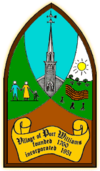Port Williams, Nova Scotia facts for kids
Quick facts for kids
Port Williams
|
||
|---|---|---|
|
Village
|
||
|
||
| Nickname(s):
The Port, P-Dubs
|
||
| Motto(s):
A Progressive Community
|
||
| Country | ||
| Province | ||
| County | Kings County | |
| Founded | 1760 | |
| Incorporated | 1951 | |
| Area | ||
| • Total | 2.93 km2 (1.13 sq mi) | |
| Highest elevation | 14 m (46 ft) | |
| Lowest elevation | 0 m (0 ft) | |
| Population
(2021)
|
||
| • Total | 1,110 | |
| • Density | 378.8/km2 (981/sq mi) | |
| Time zone | UTC-4 (AST) | |
| • Summer (DST) | UTC-3 (ADT) | |
| Postal code |
B0P 1T0
|
|
| Area code(s) | 902 | |
| Telephone Exchange | 542 | |
Port Williams is a village in Kings County, Nova Scotia, Canada. It is located on the north side of the Cornwallis River. This river is named after Edward Cornwallis, who was the first governor of Nova Scotia. In 2021, about 1,110 people lived in Port Williams.
Contents
History of Port Williams
The area where Port Williams is now was once part of an Acadian settlement called Rivière-aux-Canards. The Acadians built special walls called dykes along the river in the late 1600s. These dykes still protect valuable farmland today. This land is known for being very good for farming.
Early Settlers (1700s)
After the Expulsion of the Acadians in 1755, new settlers from New England came to the area in 1760. This was part of Cornwallis Township. The Terry and Lockwood families settled where Port Williams is now, and the place became known as Terry's Creek.
A small wooden bridge was built in 1780. A stronger bridge was built in the 1830s, which helped more people move to the area.

During the American Revolution, a local fort called Fort Hughes (Nova Scotia) was closed down in 1780. In 1781, Samuel Bayard, a major in the King's Orange Rangers, was sent to Cornwallis (near Port Williams). He was ordered to show strength to local settlers who were thinking about rebelling against the King. His soldiers marched with shining weapons and drums, which helped bring the locals back in line.
A few months later, American ships were captured by local defenders in the Battle of Blomindon. After the war, Samuel Bayard received a large piece of land at Wilmot Mountain.
Growth and Industry (1800s)
Port Williams became an important place for shipping lumber and farm products. In the days of sailing ships, the river was used a lot. Ships would come into the port to pick up apples, lumber, and potatoes. These goods were then shipped all over the world, especially to Great Britain.
The village was later renamed to honor Sir William Fenwick Williams. He was famous for fighting in a battle called the Siege of Kars. Kars Street in Port Williams is also named after this battle. Sir Williams later became the first Lieutenant Governor of Nova Scotia after Canada became a country.
The railway arrived in 1869 with the Windsor and Annapolis Railway. A station was built for Port Williams across the river in Greenwich. In 1884, an apple seller named W. H. Chase built the first apple warehouse in Nova Scotia next to the station. Many more warehouses followed in the 1890s, helping the apple industry grow quickly in Nova Scotia.
Modern Times (1900s)
Port Williams became a main center for the apple industry. It had a large factory for making barrels and a processing plant for W.H. Chase's apples. The wharves (docks) were rebuilt in 1930 for large steamships. They were used until the 1970s. Even though the apple industry slowed down after World War Two, some apple processing plants stayed in Port Williams.
From 1950 to 1971, wood for paper was shipped from the port. This wood came from the field behind the Port Williams Elementary School. When ships were at the dock, their bottoms were completely visible at low tide.
Plants for poultry, animal feed, and fuel were built near the railway. The railway stopped running to Port Williams in 2006. In 1972, the government gave $100,000 to fix up the wharf. Three years later, the widest ship ever to dock at Port Williams arrived. It brought a load of soybean meal from Chicago.
Population
In the 2021 Census, Port Williams had a population of 1,110 people. They lived in 473 of the 492 homes in the village. This was a small decrease from its 2016 population of 1,186. The village covers an area of 2.93 square kilometers.
Education
Port Williams is home to Port Williams Elementary School. It is located on Belcher Street. The current school was built in 1966. It replaced an older school that had burned down. The school has a gymnasium, a modern music room, and many classrooms.
Gallery
-
Cornwallis River near low tide
Notable Residents
- Benjamin Belcher
- Samuel Bayard of the King's Orange Rangers
- Jacob Shaffelburg - a professional soccer player for Nashville SC
- Drake Batherson - a professional hockey player for the Ottawa Senators








